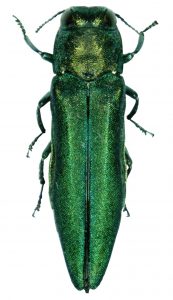 Via a post on the Nature NS Listserv by Ian Manning, I learned that the Emerald Ash Borer is now in New Brunswick: CFIA Press Release, May 17, 2018
Via a post on the Nature NS Listserv by Ian Manning, I learned that the Emerald Ash Borer is now in New Brunswick: CFIA Press Release, May 17, 2018
Some interesting perspectives follow:
CS (May 18, 2018): Interesting that there seems to be a surge of tree-destroying varmints. If we had enough birds, they might take care of it!
IM (May 18, 2018): There’s been insects that eat trees for longer than there has been birds, so don’t think that’s the issue.
In this scenario you can be pretty confident pointing the finger at people trying to save a buck on firewood while camping. If I were planting a tree on my front lawn today, ash would have dropped a couple spots on my list.
CS (May 18, 2018): I think there have always been waves of insect blooms, in just the natural resident insects, let alone those brought in by importing products. People in the woods can spread these things faster though by carrying wood around from place to place, yes, and introduce foreign species–indeed this is a problem.
The knee-jerk reaction to a wave of bugs is to douse things with spray and battle the bugs with interventions. But nature will triumph in the end if we work with the way the system works, that’s what I think.
Certain warblers for instance will thrive and produce huge numbers of young in Spruce Budworm infestation periods, it’s the way in nature to keep things in check. Bird declines worldwide are a problem in this natural system of checks and balances, because bugs can take the upper hand and cause too much devastation. But swathes of forest dying out under normal circumstances, like a resident bug proliferating, is normal, and makes way for regeneration and a different habitat. One thing I’ve learned in birding is that if we had old growth forest everywhere it’d be very limiting to the bird populations, who are varied and specific in their life history and food species. Some require young forest type settings, or even the first flush of growth including wild raspberry, “weeds” and alders and birch.
I’m saying local bugs killing groups of trees is likely going to be more sustainable and beneficial in the long run than humans trying to manage things by creating fires intentionally for example…the dead trees are there as homes and fertilizer as they rot and feed everything else over time. And infestations can give species like the Cape May Warbler a boom in population, to revive a flagging gene pool, perhaps. It’s natural, these are the natural cycles.
Foreign bugs and imported pests are a problem though, because they disrupt the balance that’s already been worked out for millennia!
FS (May 18, 2018): … it was bound to happen. I wonder if anyone knows more than this uninformative blurb from CFIA?
Our experience with this pest in eastern Ontario is that it ravaged the Ash forests of urban Ottawa, which are now dead skeletons undergrown by dense forests of Cathartic Buckthorn, but that it hasn’t spread as rapidly in the rural areas as one might have expected. I cut a couple of trees on our land two years ago, but others haven’t succumbed as rapidly as anticipated.
Apparently, there is both a biocontol wasp introduced from China, and at least one native egg parasitoid which has taken up with the invader, but as with so many biocontrol agents, it’s hard to find news of how widespread or successful these have been found to be. If the infestation in Edmunston can’t be quickly extinguished, naturalists should urge the authorities to promtly introduce both of these biocontrol Insects to the infested area.
Trees infested with the Emerald Ash Borer can be recognized by the D-shaped emergence holes made by the adults, and by the flaking away of the surface of the bark by Woodpeckers. Green Ash (F. pensylvanica) are more vulnerable than White Ash (F. americana). View CFIA Fact Sheet
Affected trees will be something else to look out for as we come to BiotaNB next month….
(I will add more as they might be posted)
